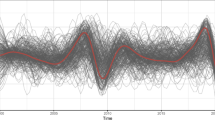Abstract
Yes it is. We rigorously demonstrate the equivalence of any stock flow consistent (SFC) model to a directed acyclic graph (DAG) using condensation graphs. The equivalence between stock flow models and DAGs is useful both for visualising large-scale macroeconomic models of this type and for inferring causality within these models. We developed a new package to build and simulate any SFC model and generate the corresponding DAGs, and we provide an example of this package using a well known model from the literature.


Similar content being viewed by others
Notes
Estimation is the process of discovering constant parameters using econometric methods such as ordinary least squares, maximum likelihood, Bayesian techniques, etc. Calibration, on the other hand, consists in finding a value for each parameter, in each period, such that the model replicates the data set.
This process is similar to the more well-known dynamic stochastic general equilibrium class of models, see Heer and Maussner (2009, Chap. 1) for an introduction.
These exogenous innovation terms will not be included in our formal description of the models.
The Github repository for the code is at github.com/S120/PKSFC, where the complete R package and documentation can be freely downloaded.
References
Bessler, D. A., Yang, J., & Wongcharupan, M. (2003). Price dynamics in the international wheat market: Modeling with error correction and directed acyclic graphs. Journal of Regional Science, 43(1), 1–33.
Caverzasi, E., & Godin, A. (2015). Post-Keynesian stock-flow-consistent modelling: A survey. Cambridge Journal of Economics, 39(1), 157–187.
Dos Santos, C. H., & Zezza, G. (2008). A simplified,‘benchmark’, stock-flow consistent post-Keynesian growth model. Metroeconomica, 59(3), 441–478.
Godley, W. (1999). Money and credit in a Keynesian model of income determination. Cambridge Journal of Economics, 23(2), 393–411.
Godley, W., & Lavoie, M. (2007). Monetary economics an integrated approach to credit, money, income, production and wealth. Basingstoke: Palgrave-Macmillan.
Heer, B., & Maussner, A. (2009). Dynamic general equilibrium modelling. Berlin: Springer.
Hoover, K. D. (2001). Causality in macroeconomics. Cambridge, MA: Cambridge University Press.
Hopcroft, J. E. (1983). Data structures and algorithms. Boston: Pearson Education.
Lauritzen, S. L. (2001). Causal inference from graphical models. In Complex stochastic systems (pp. 63–107).
Moneta, A., Entner, D., Hoyer, P. O., & Coad, A. (2013). Causal inference by independent component analysis: Theory and applications*. Oxford Bulletin of Economics and Statistics, 75(5), 705–730.
Morgan, S. L., & Winship, C. (2007). Counterfactuals and causal inference: Methods and principles for social research. New York: Cambridge University Press.
Newman, M. (2010). Networks: An introduction. Oxford: Oxford University Press.
Pearl, J. (2000). Causality: Models, reasoning and inference (Vol. 29). Cambridge: Cambridge University Press.
Pearl, J. (2009). Causality. Cambridge: Cambridge University Press.
Tarjan, R. (1972). Depth-first search and linear graph algorithms. SIAM Journal on Computing, 1(2), 146–160.
Tobin, J. (1982). Money and finance in the macroeconomic process. Journal of Money, Credit and Banking, 14(2), 171–204.
Acknowledgments
We thank Dan Neilsen and Oliver Burrows for useful comments on an earlier draft. Kinsella gratefully acknowledges the support of the Institute for New Economic Thinking under grant number INO1300030.
Author information
Authors and Affiliations
Corresponding author
Rights and permissions
About this article
Cite this article
Fennell, P.G., O’Sullivan, D.J.P., Godin, A. et al. Is It Possible to Visualise Any Stock Flow Consistent Model as a Directed Acyclic Graph?. Comput Econ 48, 307–316 (2016). https://doi.org/10.1007/s10614-015-9521-8
Accepted:
Published:
Issue Date:
DOI: https://doi.org/10.1007/s10614-015-9521-8




